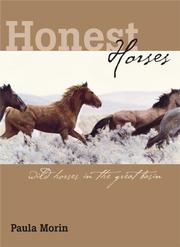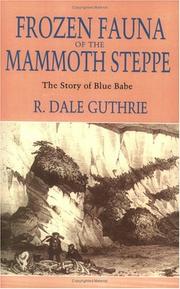| Listing 1 - 7 of 7 |
Sort by
|

ISBN: 0874176743 9780874176742 087417631X 9780874176315 087417631X 9780874176315 0874176735 9780874176735 Year: 2006 Publisher: Reno University of Nevada Press
Abstract | Keywords | Export | Availability | Bookmark
 Loading...
Loading...Choose an application
- Reference Manager
- EndNote
- RefWorks (Direct export to RefWorks)
Wild horses --- Feral horses --- Feral livestock --- Feral mammals --- Horses --- History.
Book
ISBN: 1613241402 9781613241400 9781606929629 1606929623 Year: 2009 Publisher: New York Nova Science
Abstract | Keywords | Export | Availability | Bookmark
 Loading...
Loading...Choose an application
- Reference Manager
- EndNote
- RefWorks (Direct export to RefWorks)
Wild horses --- Wild burros --- Wild horse adoption --- Management. --- United States.
Book
ISBN: 0803255004 0803254997 9781461956617 1461956617 9780803255005 9780803254992 9780803253353 0803253354 9780803255012 1496232631 Year: 2014 Publisher: Lincoln
Abstract | Keywords | Export | Availability | Bookmark
 Loading...
Loading...Choose an application
- Reference Manager
- EndNote
- RefWorks (Direct export to RefWorks)
He already owned and managed two ranches and needed a third about as much as he needed a permanent migraine: that's what Alan Day said every time his friend pestered him about an old ranch in South Dakota. But in short order, he proudly owned 35,000 pristine grassy acres. The opportunity then dropped into his lap to establish a sanctuary for unadoptable wild horses previously warehoused by the Bureau of Land Management. After Day successfully lobbied Congress, those acres became Mustang Meadows Ranch, the first government-sponsored wild horse sanctuary established in the United States.<
Mustang --- Wild horses --- Cowboys --- Ranchers --- Wildlife conservationists --- Ranch life --- Farm life --- Frontier and pioneer life --- Horse breeds --- Feral horses --- Feral livestock --- Feral mammals --- Horses --- Conservationists --- Ranchmen --- Stockmen (Animal industry) --- Farmers --- Bronco busters --- Broncobusters --- Buckaroos --- Buckeroos --- Vaqueiros --- Vaqueros --- Cattle herders --- Horsemen and horsewomen --- Gauchos --- Conservation --- Government policy --- Day, H. Alan. --- South Dakota --- State of South Dakota --- Dakota Territory --- Social life and customs.
Book
ISBN: 1421419106 9781421419107 9781421419091 1421419092 Year: 2016 Publisher: Baltimore
Abstract | Keywords | Export | Availability | Bookmark
 Loading...
Loading...Choose an application
- Reference Manager
- EndNote
- RefWorks (Direct export to RefWorks)
Readers will find new insight into the lives of the world's horses, zebras, and asses, understand the basis of our relationships with these animals, and develop a greater understanding of where equids come from and why they are worth conserving.Included in this book are detailed, state-of-the-science syntheses on Social structure, behavior, and cognition Habitat and diet Ecological niches Population dynamics Roles of humans in horse distribution through time Human dimensions and the meaning of wild Management of free-roaming horses Captive breeding of wild equids Conservation of wild equids Conservation of migrations Reintroductions Genetics and paleogenetics.
Conservation. --- Management. --- Ecology. --- Zebras. --- Horses. --- Wild horses. --- Equidae. --- Administration --- Industrial relations --- Organization --- Balance of nature --- Biology --- Bionomics --- Ecological processes --- Ecological science --- Ecological sciences --- Environment --- Environmental biology --- Oecology --- Environmental sciences --- Population biology --- Zebra --- Equus --- Equus caballus --- Farriery --- Hippology --- Horse --- Domestic animals --- Livestock --- Pachyderms --- Hinnies --- Mules --- Feral horses --- Feral livestock --- Feral mammals --- Horses --- Equids --- Perissodactyla --- Ecology

ISBN: 022615971X 9780226159713 0226311228 9780226311227 0226311236 9780226311234 Year: 1990 Publisher: Chicago
Abstract | Keywords | Export | Availability | Bookmark
 Loading...
Loading...Choose an application
- Reference Manager
- EndNote
- RefWorks (Direct export to RefWorks)
Frozen mammals of the Ice Age, preserved for millennia in the tundra, have been a source of fascination and mystery since their first discovery over two centuries ago. These mummies, their ecology, and their preservation are the subject of this compelling book by paleontologist Dale Guthrie. The 1979 find of a frozen, extinct steppe bison in an Alaskan gold mine allowed him to undertake the first scientific excavation of an Ice Age mummy in North America and to test theories about these enigmatic frozen fauna. The 36,000-year-old bison mummy, coated with blue mineral crystals, was dubbed "Blue Babe." Guthrie conveys the excitement of its excavation and shows how he made use of evidence from living animals, other Pleistocene mummies, Paleolithic art, and geological data. With photographs and scores of detailed drawings, he takes the reader through the excavation and subsequent detective work, analyzing the animal's carcass and its surroundings, the circumstances of its death, its appearance in life, the landscape it inhabited, and the processes of preservation by freezing. His examination shows that Blue Babe died in early winter, falling prey to lions that inhabited the Arctic during the Pleistocene era. Guthrie uses information gleaned from his study of Blue Babe to provide a broad picture of bison evolutionary history and ecology, including speculations on the interactions of bison and Ice Age peoples. His description of the Mammoth Steppe as a cold, dry, grassy plain is based on an entirely new way of reading the fossil record.
Blue Babe (Steppe bison). --- Paleobiology. --- Paleontology -- Alaska -- Fairbanks Region. --- Steppe bison --Alaska -- Fairbanks Region. --- Steppe bison --- Blue Babe (Steppe bison) --- Paleontology --- Paleobiology --- Geology --- Earth & Environmental Sciences --- Paleozoology --- Palaeobiology --- Biology --- Fossilogy --- Fossilology --- Palaeontology --- Paleontology, Zoological --- Historical geology --- Zoology --- Fossils --- Prehistoric animals in motion pictures --- Mummified animals --- Bison priscus --- Bos priscus --- Bison, Fossil --- mammals, fossils, ice age, preservation, bison, mummy, blue babe, excavation, science, research, pleistocene, paleolithic art, geology, carcass, death, freezing, extinction, evolution, history, ecology, mammoth steppe, plain, alaska, fairbanks, paleontology, ethology, nonfiction, phylogeny, hunting, animal human relationships, tundra, wild horses, lions, bushland, grazing.
Book
ISBN: 0774828390 9780774828390 9780774828406 0774828404 Year: 2014 Publisher: Vancouver
Abstract | Keywords | Export | Availability | Bookmark
 Loading...
Loading...Choose an application
- Reference Manager
- EndNote
- RefWorks (Direct export to RefWorks)
The ranchers who resettled BC's interior in the late nineteenth and early twentieth centuries depended on grassland for their cattle, but in this they faced some unlikely competition from grasshoppers and wild horses. With the help of the government, settlers resolved to rid the range of both. Resettling the Range explores the ecology and history of the grassland and the people who lived there by looking closely at these eradication efforts. In the claims of "range improvement" and "rational land use," author John Thistle uncovers more complicated stories of marginalization: the destruction of wild horses worked to dispossess aboriginal people, while the campaign to exterminate grasshoppers exposed class conflicts and competing versions of resettlement among immigrant ranchers.This unconventional history examines the lasting effects of range improvement, revealing a fascinating - and troubling - chapter of BC history.
Range ecology --- Grassland ecology --- Wild horses --- Feral horses --- Feral livestock --- Feral mammals --- Horses --- Grasslands --- Ecology --- Rangeland ecology --- Rangelands --- History. --- British Columbia --- British Columbia. --- Environmental conditions. --- BC --- Britaniya Kolumbiyası --- Britanska Kolumbii͡ --- Britanska Kolumbija --- Briti Columbia --- Britisch-Kolumbien --- British Columbia (Colony) --- Britisk Columbia --- Brits-Kolombi --- Britská Kolumbie --- Brytanskai͡a Kalumbii͡ --- C.-B. (Province) --- Colombie-Britannique --- Colony of British Columbia --- Colúmbia Britànica --- Province of British Columbia --- United Colonies of Vancouver Island and British Columbia --- Vretanikē Kolomvia --- Brits-Kolombië --- Брытанская Калумбія --- Brytanskai︠a︡ Kalumbii︠a︡ --- Британска Колумбия --- Britanska Kolumbii︠a︡ --- Βρετανικη Κολομβια --- B.C. (British Columbia) --- Vancouver Island (Colony)
Book
ISBN: 9780874179675 087417967X 9780874179668 0874179661 0874179661 9780874179675 Year: 2015 Publisher: Reno, Nevada
Abstract | Keywords | Export | Availability | Bookmark
 Loading...
Loading...Choose an application
- Reference Manager
- EndNote
- RefWorks (Direct export to RefWorks)
Wildlife conservation --- Mustang --- Wild horses --- Feral horses --- Feral livestock --- Feral mammals --- Horses --- Horse breeds --- Animal conservation --- Animals --- Conservation of wildlife --- Preservation of wildlife --- Protection of wildlife --- Species conservation --- Species preservation --- Species protection --- Wildlife preservation --- Wildlife protection --- Wildlife resources conservation --- Wildlife resources preservation --- Wildlife resources protection --- Conservation of natural resources --- Nature conservation --- Endangered species --- Wildlife management --- Government policy --- Management. --- Conservation --- Pryor Mountain Wild Horse Range (Mont. and Wyo.) --- Pryor Mountain National Wild Horse Range (Mont. and Wyo.) --- Pryor Mountains National Wild Horse Range (Mont. and Wyo.) --- History
| Listing 1 - 7 of 7 |
Sort by
|

 Search
Search Feedback
Feedback About UniCat
About UniCat  Help
Help News
News